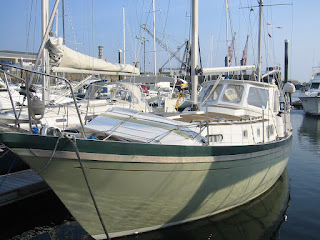Well I didn’t quite get to the point of listing suitable boats this weekend but I’m getting closer to specifying what I’m looking for. Here's a checklist ( love checklists). If you're on the same course, feel free to use it for setting out your own preferences.
Specification
|
Rationale
|
Sailing boat
|
Cruising not limited by
fuel. The wind is (kind of free). Sailing is more fun and more comfortable
than power. Technology is more understandable to me. I have time in plenty
but money is a scarcer resource
|
Rig
|
Gunter would be really
interesting - more sail control. Simple rig. Mast can be lowered or raised
more easily for rivers and canals. Masts are easier to stow, within the
length of the boat – no overhangs. If not, may have to put up with standard
Bermudan. I’m assuming she’ll be a sloop or a cutter. Can’t imagine I’ll find
a two master on such a small boat. Gaff might be fun. Haven’t considered a
junk rig although some people swear by them.
|
Overall length
|
Accommodation on less
than a 22ft hull would be cramped for two people on an extended cruise. Above
25ft makes single-handed sailing and maintenance more difficult
|
Accommodation
|
Happy to sacrifice
cockpit space for cabin space. The larger the cabin the better
|
Draft / Keel
|
Shallow draft (less than
3ft) for canal work. Traditional keel for directional stability. Bilge keels
so she can take the ground. Triple keel or long keel with bilge plates may be
ideal. NO fin keel.
|
Engine
|
Powerful enough to drive
the boat at maximum hull speed. Inboard if necessary. No transom hung outboard
(just too plain ugly) Outboard in a well would be really good
|
Material
|
GRP, sheathed Ply? (More
info needed). Steel might be too heavy on a boat of this size. Not confident with wood Restoring or
maintaining a wooden vessel would be beyond my level of skill.
|
Reputation
|
A boat with a reputation
as a good sea boat. Safe and predictable even if slow. No skittish racing
vessels. A traditional strong sea boat is first priority
|
Looks
|
If she meets the above
criteria she’ll look good in my eyes anyway
|
Condition
|
Beggars can’t be choosers
but she has to be ‘recoverable’ preferably through cleaning, polishing and
painting. Essentially the hull, decks,
mast and engine have to be sound (even if sad and neglected looking)
|
Age
|
Immaterial. There is an
argument that says the older GRP boats were more strongly built (over built)
because the technology wasn’t fully understood
|
Price
|
As low as possible.
£10,000 is all I have for both purchase and renovation. Assume 50% on
purchase and 50% on renovation?
|
Summary:
Wanted
22-24ft, GRP,
shallow draft, Gunter sloop, inboard engine (or outboard in well), good
accommodation for size, traditional, bilge or triple keel. With an excellent
reputation as a sea-boat.
Why this kind of boat (see initial Post 'introduction')
Why this kind of boat (see initial Post 'introduction')
Come on shipmates - if I've overlooked something tell me now before I start going down blind alleys (or sailing up inappropriate creaks)
Seaward





































